JAWS At 40: ‘DEJAW VU’
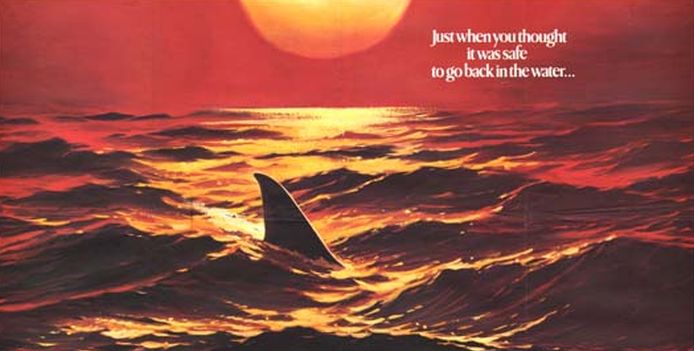
Lapsed scriptwriter and dad, currently failing to encourage my children…
Editorial note: Today, the original Jaws movie is celebrating its 40th anniversary.
There are as many kangaroos on Saturn as there are people who think that Jaws 2 was an improvement on the 1975 original. More than just a game-changing phenomenon, Jaws was an instant classic; iconic after a single viewing and still improving forty years later. The doomed task of replicating this modern masterpiece was the ultimate ‘hiding to nothing’ proposition; a track race with nothing but quicksand past the finishing line.
The resulting film, released in 1978 was predictably a wan facsimile of the first film but it was still a big success for Universal, taking US$187m off a (bloated) budget of $30m. It also benefits from a contemporary vantage point that now sandwiches it between the original classic and two further sequels of unimaginably poor quality.
Furthermore, as per Jaws The First, the effort to bring it to the screen was a nightmare of conflict and misfortune that left casualties on the battlefield. So while we rightly honour the 40th anniversary of one of the greatest and most important Hollywood movies ever made, spare a thought too for its scrappy younger brother…
The Show Must Go On: “Jaws 2 Was Obligatory”
Ten years before Jaws, the idea of a sequel would have been beyond the pale even to a studio executive. Cheap and exploitative, much like the B-movie end run of Universal horror movies, sequels were, as Steven Spielberg put it at the time, “a cheap carny trick.” However, Jaws producer Richard D Zanuck had changed the landscape with his own Planet of The Apes in 1968 and the four sequels that made annual appearances in the early 1970s.
Best Picture winner The Godfather Part II had made the sequel a respectable commodity in 1974, so when Jaws brought home $470m a year later, Jaws II (sic) was green-lit with immediate effect. As producer David Brown put it succinctly, “Jaws 2 was obligatory.”
The suggestion that Spielberg was actually prepared to direct Jaws 2 is as regularly cited by various sources as it is denied vehemently by others. His commitment to Close Encounters of The Third Kind’s punishing schedule ruled him out of contention in any case, as Universal had already cemented Jaws 2’s opening date of June 16th 1978 with theatre owners.
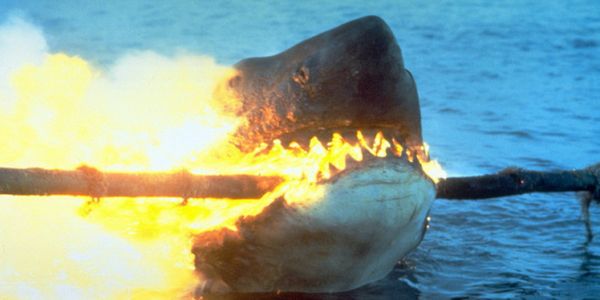
Production designer Joe Alves claims that both Otto Preminger and John Frankenheimer were approached to direct, but in the end Zanuck and Brown followed a bold suggestion by their scriptwriter, Howard Sackler. Sackler was one of the unsung heroes of Jaws; he gamely provided a script rewrite without arbitrating for a writing credit. Spielberg cites him as the originator of the celebrated USS Indianapolis speech – John Milius and Robert Shaw being the other two horses on the “I wrote that, actually” carousel.
Teething Troubles
Sackler’s initial pitch was to base Jaws 2 around the Indianapolis incident in 1945, but the producers felt that, in Brown’s words, “It was too far from the mothership,” and thoughts drifted back to Amity Island. (Bizarrely, Arthur C Clarke also submitted a draft for a Jaws sequel featuring a sentient underwater orb that controlled the will of the shark, which was politely turned down by Zanuck & Brown.)
A noted playwright whose scriptwriting career included The Great White Hope in 1970 and Stanley Kubrick’s first movies, Fear and Desire and Killer’s Kiss, Howard Sackler recommended a young, up-and-coming director, John D. Hanc*ck who had been making waves with films like Bang The Drum Slowly with Robert DeNiro in 1973 and Let’s Scare Jessica To Death with Zohra Lampert in 1971.
Hanc*ck was handed the reins to Jaws 2 and (to Sackler’s chagrin) Hanc*ck’s wife, Dorothy Tristan was hired to rewrite his own first draft. The decision to set the sequel in Amity Island again led to one more major headache: casting. Richard Dreyfuss, (Matt Hooper) was locked into Spielberg’s Close Encounters shoot and in any case was disinclined to blot his flowering CV with anything as tawdry as a sequel (he was Academy Award-bound the following year in Neil Simon’s The Goodbye Girl).
Make Him An Offer He Can’t Refuse: Reassembling The Cast
Roy Scheider, police chief in the original, too had no intention of returning to the fold and made himself as unavailable as possible by shooting back-to-back films like Marathon Man, Sorcerer and The Deer Hunter. However, with only weeks left before shooting The Deer Hunter, Scheider suddenly left the project, unhappy with the idea that his character, Michael (at that point, called ‘Merle’), having travelled all the way to Saigon to find him, would let his best friend shoot himself in the head playing Russian Roulette at the film’s climax.
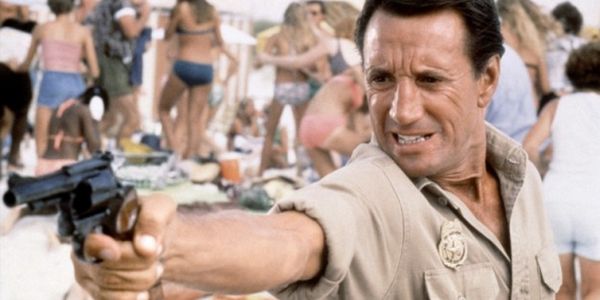
The Deer Hunter was the second film in a three-picture deal Scheider had made with Universal when he signed up to star in Jaws. With the threat of legal action hovering, Universal head Sid Sheinberg used the Jaws sequel as leverage to secure the return of Chief Martin Brody. Scheider eventually agreed but only if Jaws 2 counted as both remaining films in his three-movie contract.
He also made a pretty penny from the deal: according to his biography, “he agreed to financial terms that quadrupled his base salary from the first Jaws film. [He] also negotiated for points, a percentage of the film’s net profits…plus a $35,000 bonus for each week past that the shooting schedule ran over.”
This final caveat may have proved the most lucrative sub-clause because just as shooting on the first film was a maelstrom of misfortune, misery and delay, the set of Jaws 2 was a disaster from the first snap of the clapperboard onwards. After one month of filming, the production hand-braked to a standstill when John D Hanc*ck was suddenly fired by the producers. Rumours quickly circulated that his vision was too dark; that he was ill-equipped to film action sequences and that he spent too long going shopping at the weekends.
Seemingly, his dismissal was actually the result of studio politics. The epicentre of this explosion was the participation of Sid Sheinberg’s girlfriend, Lorraine Gary, who played Martin Brody’s wife, Ellen – her casting in the first film was a cause of mild, but ultimately benign concern back in 1974. Sheinberg had suggested to Hanc*ck that Ellen Brody should accompany her husband during the rescue of their children at the film’s climax. When Hanc*ck brought up the idea with Zanuck, the producer replied, “Over my dead body.” Hanc*ck’s wife, Dorothy, duly redrafted the screenplay.
Hanc*ck explained, “We turned in the next draft without Lorraine Gary going out on the boat to rescue the kids. Sheinberg never met my eyes in the commissary again. During rehearsals, I fired an actress for a small part. She turned out to be the girlfriend of another executive at Universal. That spelled my demise. Verna Fields had a role in it. She felt she should have been offered the directorship based on her editing. It was politics and I made enough mistakes that I got in trouble….Obviously, what I should have done then was to get Zanuck and Sheinberg in the same room and say, “Okay you guys should give me direction because I really don’t want to get in between you two.” I was caught between these two huge forces like a babe in the woods and paid the price for it.”
Seen The Movie? Now Read The Book!
Hanc*ck and his wife left the project together, taking a Lear jet to Rome and laid low. “Jaws 2,” he concluded, “is a very bitter, painful experience that took years to recover from.” It is a matter of feverish speculation among Jaws fans to imagine how John D Hanc*ck’s Jaws 2 would have differed from the final product. A reliable indicator can be found in the (surprisingly fine) novelisation by Hank Searls, which was adapted from the first draft screenplay – tellingly, Dorothy Tristan and not her replacement Carl Gottlieb is credited on the book’s cover.
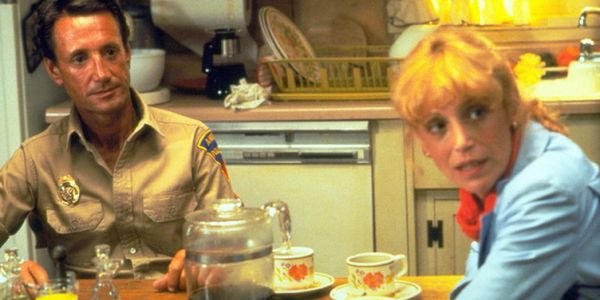
Amity, in this version, is a boarded-up ghost town on its uppers. Salvation is at hand in the form of a huge, sea-front casino which is being developed with mob money, continuing a Mafia link from Peter Benchley’s original novel that Spielberg had discarded. Chief Brody’s unsubstantiated shark paranoia is seen as a threat to the development of the casino, and at one point it is suggested that Brody even lied about having killed the first shark. It is also made clear that the new shark is a pregnant female, leading to the mechanical model being Christened ‘Brucette’ – though on the set, it was called ‘Harold,’ after David Brown’s lawyer.
Who Shall Take This Poisoned Chalice? A Director Steps In
Gingerly, the producers approached Spielberg again to reconsider the idea of coming back, but his insistence on an extra five months to write a new script proved impossible to accommodate. Bravely, Joe Alves recommended a French-American director with whom he had worked on Rod Serling’s popular TV show, Night Gallery: Jeannot Szwarc had made a good name for himself as a television director on shows like Ironside, The Six Million Dollar Man and Kojak. In 1975, he directed legendary showman William Castle’s final production, Bug about a plague of fire-raising c*ckroaches.
Szwarc had a reputation for dependability and professionalism, which was exactly what Zanuck and Brown wanted. Szwarc asked for a rewrite to better flesh out the characters while he started work filming the key action sequences – beginning with the shark attack on the water-skier and the subsequent speedboat explosion. It was Szwarc who instigated the return of Brody’s deputy, Hendricks (played by Jeffrey Kramer) and replaced The Sting actor Dana Elcar as developer Len Peterson with Joseph Mascolo, with whom he had worked on Kojak. The aforementioned Carl Gottlieb, returning from co-scriptwriting-duty on the first movie, was recruited to rewrite the Sackler/Tristan screenplay.
One of the biggest critical brickbats (justifiably) used to pelt Jaws 2 is that the magnificent trio of Brody, Hooper and Quint was replaced as shark-bait by a group of nondescript adolescents, pushing the franchise into post-Halloween slasher-film territory; what Roger Ebert defined as the “Dead Teenager Movie.”
Firstly, since Jaws 2 was released several months before Halloween, it can tentatively claim to have popularised the teen-stalking genre in the first place. In reality Gottlieb’s intentions were less cynical than that: “I had this notion (about) the cruising culture that was very popular with cars at the time; what if kids cruised on the water the way they cruised on the boulevard?” With the script in place and a director supplying dailies that pleased the producers, the storm clouds finally appeared to have lifted…but not for long.
‘Star’ Wars: The Ego Has Landed
The Jaws 2 set had to contend with a phenomenon that was notably absent from the first movie – a genuine movie star. A relatively unknown character actor in 1974, Roy Scheider was now the star of the biggest movie of all time: an above-the-title marquee-name with directors like William Friedkin and John Schlesinger on his resume. Scheider was unhappy to have been press-ganged into Jaws 2 in the first place, and word soon spread to Zanuck and Brown that he was locking antlers with Jeannot Szwarc at every possible opportunity.
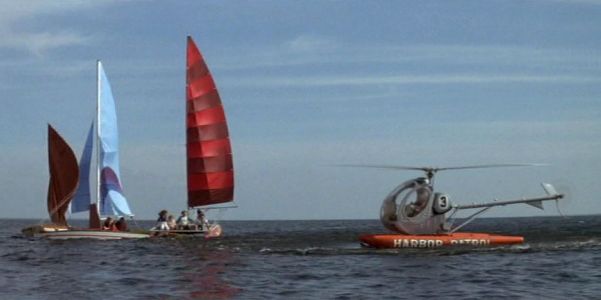
David Brown describes a summit meeting in his hotel room between his star, his director and Jaws editor and Universal VP, Verna Fields. “Jeannot remarked to Scheider, “You have quite an ego.” Scheider exclaimed, “I have an ego? Why you son of a bitch!” He grabbed Szwarc and flung him against the wall. Szwarc was fifty pounds heavier but Roy was in great shape. They started wrestling. When they fell on the floor, I piled on top of them. Verna screamed, “Don’t hurt his face!” She didn’t mean me or Jeannot. Verna decided to enter the fray and (sit) on top of us. Verna was so heavy that we screamed for mercy and started to laugh uncontrollably as we disentangled ourselves. Once freed, I put a bottle of scotch on the table and poured enough into each glass to get us gloriously drunk.”
Familiarity Breeds Contempt…
Jaws 2 suffers from the usual symptoms of sequelitis, made especially acute by the loss of the ‘shark’s point-of-view’ technique from the first film which added so much tension and suspense. Szwarc was adamant that despite the same special effects headaches that made Jaws such a nightmare to shoot, the shark had to be a more prominent character in the sequel. ‘I kept saying from the beginning, “We must show the shark a lot,”’ said Szwarc, “because that image of the shark coming out of the water for the first time – it already happened in the first one.”
Compounding the fact that three years of technical advancement in the field of visual effects still hadn’t solved the inherent problem of a rubbery-looking mechanical shark, this front-loading of the monster robbed the film of a potentially intriguing idea: that Brody really is having a complete nervous breakdown and is seeing sharks around every corner.
Since the audience is aware that a great white really is responsible for the carnage, the validity of Brody’s obsession is never in doubt, something that gave Scheider cause for concern: “In the first Jaws, the entire town knew there was a monster out there. This movie is different. Only the audience knows. Not even Brody is sure. I’ll be doing my damnedest to play everything light enough so the character (says) to himself, “Aaaaah, maybe I’m crazy,” or else I’ll look like an ass.”
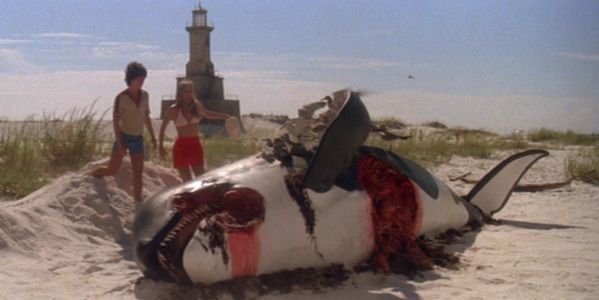
Another squandered element is raised during the scene where a half-eaten killer whale is found on the beach – a quid pro quo “Screw You” to Dino de Laurentiis, after his derivative Orca…Killer Whale (1977) opened with a scene showing a killer whale mauling a great white shark. Brody asks a humourless ichthyologist, “Do you think it’s possible that if one shark were destroyed, that another one would take its place…?” The concept of a shark taking things personally would go on to bear unintentionally hilarious fruit in the series nadir, Jaws: The Revenge.
And yet one of Jaws 2’s greatest moments – the townsfolk are gathered at a party and the camera moves out across the harbour, ropes clanging against masts as tides lap uninhabited boats, and a huge dorsal fin breaks the water, seemingly circling the town – does suggest that a wraith-like presence has returned to punish the people for a former wrongdoing. An unspoken, open-ended High Plains Drifter-style reading is thus offered up but as is often the case in Jaws 2, the idea goes nowhere.
Spinning Silver From Straw: The Occasional Merits of Jaws 2
The continued presence of many of the characters from the first film (right down to the type font used in the titles and credits – ‘Souvenir Bold,’ in case you’re interested) helps to paper over many of the cracks in Jaws 2. The most important returnee is composer John Williams, who surpasses himself with a score as hypnotic and ethereal as it is shocking and relentless. Charley Varrick cinematographer Michael C Butler (no relation to Jaws DP Bill Butler) paints an evocative, dusky and Autumnal Amity Island, though the fact that it took three editors to try and fail to emulate Verna Fields speaks volumes.
It says a lot about Roy Scheider’s professionalism too that despite the fact that he was cast essentially against his will, he gives a marvellous performance as a dutiful family man starting to unravel. Ignoring the political hoo-hah, Lorraine Gary is perfectly cast as Ellen Brody. Her scenes with Scheider have an unfakeable domestic intimacy and she excels in a role much expanded from the first film. There are also welcome reappearances from Fritzi Jane “Are you going to close the beaches” Courtney, and Alfred Wilde, as Harry (he of the bad hat).
Murray Hamilton’s Mayor Larry Vaughan is a suitably crushed figure in his sophomore appearance. With the face and posture of a withered pumpkin (and the wardrobe of a 1970s carpet salesman), the weight of the terrible events of the first film press down on him all the way through the sequel. He is broken and (in the scene where he asks Len Peterson to wave to his son) childishly demented. On the DVD, David Brown reveals that a gravely ill Hamilton fled the set early to attend to his wife’s emergency operation and died shortly afterwards – which must have come as a shock to Murray Hamilton who didn’t actually pass away until 1986.
“Jaws 2 Was Passable”: The Final Analysis
Critical opinion of sequels has to take into account the fact that unlike the original films upon which they are based, sequels are green-lit and produced with the solitary aim of exploiting a pre-existing fan base. This motivation has to be taken into consideration when assessing the end-product.
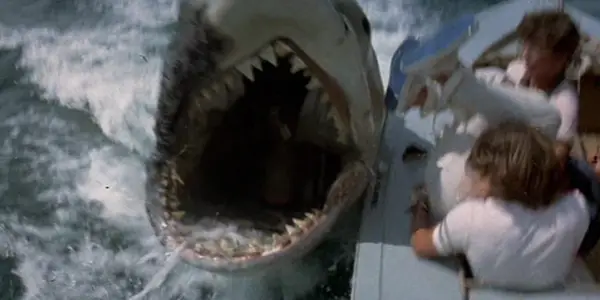
As such, taken on its own terms, Jaws 2 is a perfectly watchable, well-produced, competently-directed thriller, well played by a fine cast with a genuinely exciting climax…that doesn’t really amount to anything more than that. No one’s ever going to look for Vietnam allegories or Ibsen references here. It’s the B-side to Jaws’s big hit A-side, but still demonstrably part of the same pressing.
“As it turned out,” Roy Scheider summed up, “Jaws 2 was passable.” David Brown reasoned that “if we didn’t make it, somebody else would make it and we felt very protective about it.” The reality of somebody less protective making it would emerge five years later in the camcorder-quality abomination that was Jaws 3-D. In light of the sequels that followed it Jaws 2 is, if anything, a better film than anyone had the right to expect.
Its initial success – according to Brown, “Jaws 2 did about a third or maybe 40% of the original, which was gargantuan” – led to a sea-change in studio thinking about franchises and sequels that still persists today. Whether this is a good thing or not is debatable.
One thing Jaws 2 can undoubtedly boast about is its justifiable claim to have been marketed using one of the greatest, most parodied tagline of the last fifty years. If Jeannot Szwarc had a nickel for every time someone said “Just when you thought it was safe to go back into the water…” he’d be a wealthier man than Steven Spielberg.
Are there any other beleagured sequels that you feel should be given a second chance? Superman III perhaps? Mad Max Beyond Thunderdome? X-Men: The Last Stand? (Any Cannonball Run II champions, it should be noted, are obliged to keep their opinions to themselves!)
sources:
Just WhenYou Thought It Was Safe: A Jaws Companion by Patrick Jankiewicy
Nigel Andrews on Jaws (Bloomsbury)
Roy Scheider: A Film Biography by Diane C Kachmar
The Making of Jaws 2 (directed by Laurent Bouzereau)
(top image source: Universal Pictures)
Does content like this matter to you?
Become a Member and support film journalism. Unlock access to all of Film Inquiry`s great articles. Join a community of like-minded readers who are passionate about cinema - get access to our private members Network, give back to independent filmmakers, and more.
Lapsed scriptwriter and dad, currently failing to encourage my children to watch black and white films. Alter-ego: a mild-mannered restaurateur in north Wales. Have been writing about films and food for three years in magazines like Cinema Retro and The Chap, and on websites like HeyUGuys.com and Taste of Cinema. Obsessed by cinema in all its forms.













